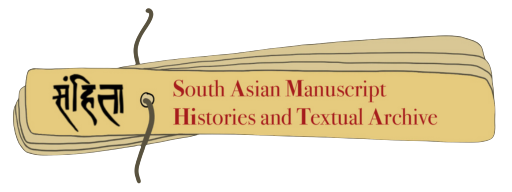Manuscripts
Search Filter
Bhairavānanda-nāṭaka
EAP790/21/122 Language : Sanskrit Scripts : Newari
An incomplete manuscript on Bhairavānanda-nāṭaka by Maṇika, son of Rājavardhana. He was a Nepali playwriter, was the pupil of Naṭśvara. He came to the Malla court from Mithila. The story of this drama revolve around Bhairavānanda and Madanāvatī. Madanāvatī a celestial young lady cursed by a sage. This play was performed during the marriage of Jayadharma Malla Deva of Nepal.
Bhairavānanda-nāṭaka
EAP790/21/123 Language : Sanskrit Scripts : Newari
An incomplete manuscript on Bhairavānanda-nāṭaka by Maṇika, son of Rājavardhana. He was a Nepali playwriter, was the pupil of Naṭśvara. He came to the Malla court from Mithila. The story of this drama revolve around Bhairavānanda and Madanāvatī. Madanāvatī a celestial young lady cursed by a sage. This play was performed during the marriage of Jayadharma Malla Deva of Nepal.
Saptaśatīcaṇḍī
EAP790/21/84 Language : Sanskrit Scripts : Newari
Saptasati Chandi is the eulogy of Goddess Durga. It is chanted during the Navaratri festival in the April and October every year. Durga Saptashati is the base and root of the Shakta tradition. It has several Mantras contained in the book.
Kṛtyaratnāvalī
EAP790/21/74 Language : Sanskrit Scripts : Devanagari
An incomplete manuscript on Kṛtyaratnāvalī, a Dharmaśāstra text by Rāmacandra Tatsat. He was the son of Viṭṭhala and grandson of Bālakṛṣṇa Tatsat. The text discusses śraddha ritual.
Pañcarakṣā Sūtra
EAP1023/25/36 Language : Sanskrit Scripts : Newari
Pancharaksha Sutra is a Buddhist Protective Sutra belonging to Mahayana Buddhism. There are five sutra that constitute Pancharaksha. They are to protect from evil deeds or bad planets . It was written in Nepal Samvat 762.
Skandapurāṇa
EAP1023/25/37 Language : Sanskrit Scripts : Bengali
The Skanda Purana [Skandapurāṇa] is the largest Mahapurana, a genre of eighteen Hindu religious texts. The text contains over 81,000 verses, and is part of Shaivite literature. It is titled after Skanda, a son of Shiva and Parvati, who is also known as Kartikeya. While the text is named after Skanda, he does not feature either more or less prominently in this text than in other Shiva-related Puranas. The text has been an important historical record and influence on the Hindu traditions related to the war-god Skanda.
Prayogaratnam
EAP1023/25/38 Language : Sanskrit Scripts : Devanagari
A Dharmaśāstra text by Nārāyaṇa Bhaṭṭa(1513 C.E.), son of Rāmeśvara Bhaṭṭa. The text discusses Saṃskāra inspired from Āśvalāyana-smṛti.
Daśakarma
EAP1023/25/39 Language : Sanskrit Scripts : Devanagari
This is a ten life cycle rituals of the Hindus. It starts from 'Garbhadhan' to ' Samavartanam. Those rituals are observed by the Hindus in India and Nepal.
Brahmottara-khaṇḍa
EAP1023/25/40 Language : Sanskrit Scripts : Devanagari
This manuscript is the Brahmmottara Khanda of Skandha Purana [Skandapurāṇa].
Mahābhārata Droṇaparva
EAP1023/25/41 Language : Sanskrit Scripts : Devanagari
He Drona Parva in the Mahabharata [Mahābhārata] is the seventh of eighteen books of the famous Hindu epic Mahabharata [Mahābhārata]. Drona Parva traditionally has 8 sub-books and 204 chapters. But the critical edition of Drona Parva has 8 sub-books and 173 chapters. It describes the appointment of Drona as commander-in-chief of the Kaurava alliance, on the 11th day of the Kurukshetra War, the next four days of battles, and his death on the 15th day of the 18-day war. This Parva recites how the war became more brutal with each passing day.
Dinakaroddyota
EAP1023/25/42 Language : Sanskrit Scripts : Devanagari
A text on Dharmaśāstra start by Dinakara Bhaṭṭa and completed by his son Viśveśvara alias Gāgā Bhaṭṭa, both of them belongs to the famous Bhaṭṭa family. Dinakara was the grandson of Nārāyaṇa Bhaṭṭa and son of Rāmakṛṣṇa Bhaṭṭa.
Vidhānapārijāta
EAP1023/25/44 Language : Sanskrit Scripts : Devanagari
This text is the book of marriage rituals. This is the fourth chapter of the text.













